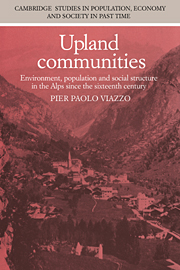 Upland Communities
Upland Communities Published online by Cambridge University Press: 13 October 2009
The decline of mountain farming
The preceding chapter has suggested that in the study of recent trends in Alpine demography it is sometimes difficult to distinguish between short-term fluctuations and deeper structural transformations. On the other hand, it would seem hardly open to question that in the economic sphere the spectacular changes which have occurred in the last few decades, and particularly the decline of mountain farming, represent radical departures from the past. To be sure, villages where the majority of the labour force is engaged in farming still do exist, but they are much less numerous now than they were only twenty or thirty years ago. Moreover, these villages are the ones where mountain depopulation has been most pronounced. Swiss studies, corroborated by recent data on the Italian Western Alps, indicate that predominantly agro-pastoral communities now tend to have less than 300 inhabitants. If we further consider that people of prime working age are often outnumbered by pensioners, it becomes clear that in these villages the seeming stability of the occupational structure masks a crisis of agricultural and pastoral activities which is no less serious than in peasant-worker communities or in tourist resorts.
The census data used by geographers and economists in their analyses of post-war economic trends leave no doubt that in the last forty years the decline of mountain farming has been general (and, in all likelihood, irreversible) throughout the Alpine area.
To save this book to your Kindle, first ensure [email protected] is added to your Approved Personal Document E-mail List under your Personal Document Settings on the Manage Your Content and Devices page of your Amazon account. Then enter the ‘name’ part of your Kindle email address below. Find out more about saving to your Kindle.
Note you can select to save to either the @free.kindle.com or @kindle.com variations. ‘@free.kindle.com’ emails are free but can only be saved to your device when it is connected to wi-fi. ‘@kindle.com’ emails can be delivered even when you are not connected to wi-fi, but note that service fees apply.
Find out more about the Kindle Personal Document Service.
To save content items to your account, please confirm that you agree to abide by our usage policies. If this is the first time you use this feature, you will be asked to authorise Cambridge Core to connect with your account. Find out more about saving content to Dropbox.
To save content items to your account, please confirm that you agree to abide by our usage policies. If this is the first time you use this feature, you will be asked to authorise Cambridge Core to connect with your account. Find out more about saving content to Google Drive.